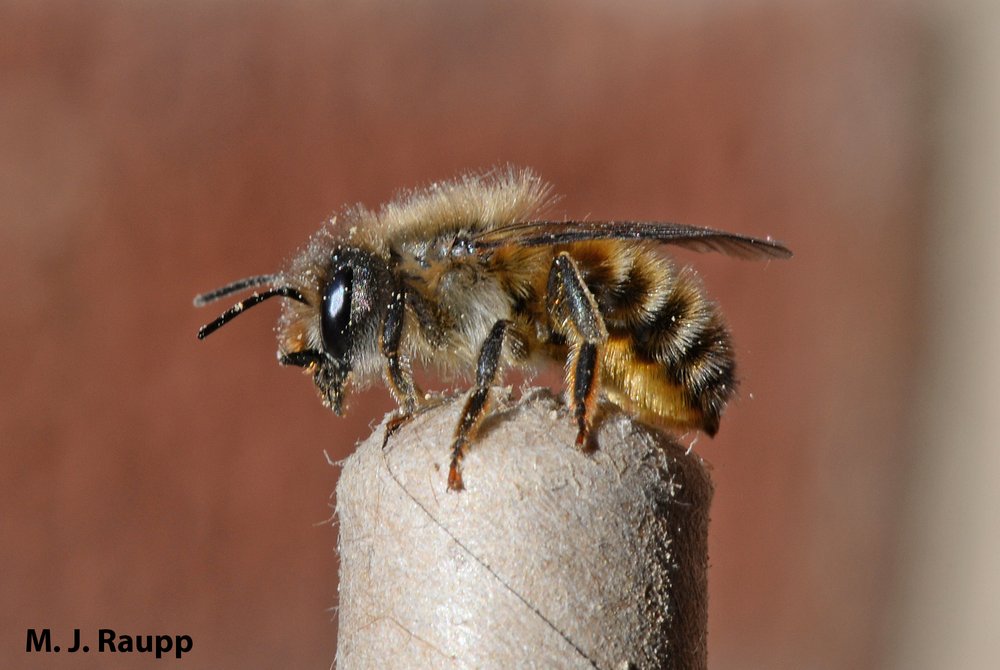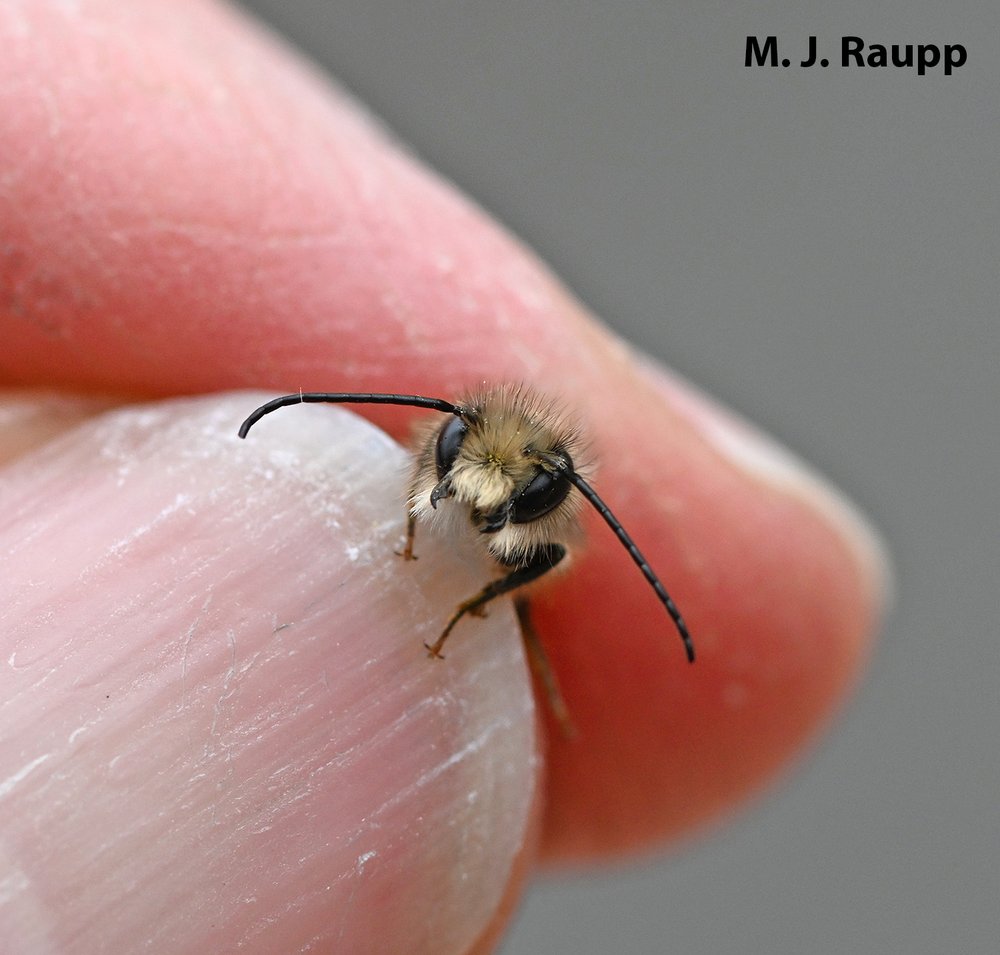
A newly minted horn-faced mason bee prepares to take her first flight. Golden hairs called scopa line her abdomen. These will be festooned with pollen when she returns to her gallery to make pollen cakes for her young.

Cardboard tubes and drilled firewood make suitable accommodations for mason bees.
Our saga of insects active in early spring continues this week, following previous episodes featuring home invaders like stink bugs and boxelder bugs, and charismatic plasterer bees. This week we pay homage to another group of bees that help keep the plant world humming. A few weeks ago, on March 7, male horn-faced mason bees débuted after spending a chilly winter in their galleries. In nature, mason bees exploit galleries made in trees by other insects, like wood-boring beetles, as nesting sites for their young. To enjoy these pollinators on a more regular basis, several years ago I established a colony of mason bees by purchasing about 30 hollow cardboard tubes from a purveyor of bee paraphernalia. These tubes were rapidly colonized by grateful hordes of mason bees. Each year I have augmented my colony by drilling dozens of small holes in unused splits of maple and oak firewood. The bees have happily obliged by filling every gallery until my colony now numbers nearly a thousand bees.
In the wild, mason bees use galleries in trunks of dead trees as homes for their brood. Watch as these mason bees check old beetle emergence holes in a standing dead tree.

Male mason bees emerge before females each season in a phenomenon known as protandry.
Last spring mason bees filled brood chambers with pollen and eggs and sealed these chambers with mud (hence the name mason bee). The earthen plug keeps out predators and parasitoids intent on feasting on larval mason bees. During last spring, summer, and autumn, bee larvae developed within the galleries dining on pollen cakes designed by their industrious mothers. Over the past few weeks, as the morning sunshine warmed the tubes and logs, earthen plugs were dismantled as fresh new bees set themselves free from juvenile confinement. Like many of members of the insect clan, male mason bees complete development and emerge several days in advance of their future mates. This phenomenon, called protandry, is relatively common in the insect world, as noted by Charles Darwin in his famous work, "The Descent of Man." Throughout the realm of insects, female mason bees are held in high esteem and finding just the right mate is a high priority in the mating game. Apparently, males that emerge early in the season have more opportunity to find and secure mates. Males that are slow to develop and emerge late may find all of the available ladies taken by earlier suitors. These latecomers may ultimately lose in the bee mating game.
After breaking through the earthen plug, a male horn-faced mason bee tidies up before searching for a mate.
For several days, newly emerged male mason bees swarmed around my colony, and I was not surprised to see one of the first females of the season quickly captured, mated, and guarded by an eager male bee.
To prevent interlopers from mating with a female, males guard their mates long after mating is complete.
Mason bees are solitary bees, meaning they lack the well-known social structure of honey bees where a queen mother rules the colony. In the world of mason bees, every female is a queen tasked with providing food for her own daughters and sons. Mason bees provide the valuable ecosystem service of pollination. High on their list of favored plants are some of my favorites as well, apples, cherries, blueberries, and almonds. In a fascinating study Drs. MacIvor, Cabral, and Packer found that in addition to insect pollinated plants, some Canadian mason bees collected significant pollen from wind-pollinated trees, including oaks and birches, and also from the ubiquitous lawn weed, white clover. Upon returning to the cardboard tubes or wooden galleries, females turn pollen and nectar into pollen cakes, the source of food for their bee babies.
Watch as busy blue orchard mason bees and horned faced mason bees enter galleries head first, then emerge, pirouette, and back into their gallery. Is this how they add pollen from their abdomen to the pollen cake?

Glorious yellow pollen cakes line each cardboard tube and gallery.
Provisioning the brood galleries involves an interesting mason bee dance. Returning from a flower, the mother bee enters the gallery head first. She then backs out of the gallery rear-end first and pirouettes 180 degrees, reentering the gallery backwards. After transferring pollen from the hairs on her body to the pollen cake, she departs to search for another load of nectar and pollen. Before each cake is sealed in a chamber, the female mason bee deposits an egg on it. Eggs hatch into tiny bee larvae that consume the cake as they develop and grow throughout the summer and fall. After completing development during autumn, they hunker down for winter, and are ready to emerge just in time for the return of spring and the blossoms of flowering plants. Like many other bees we have met in Bug of the Week, mason bees are gentle and not at all interested in stinging humans. I handled several adults and received a couple of cautionary bites, but never a sting. Nesting materials for mason bees can be purchased commercially and I highly recommend creating habitats for these industrious and fascinating pollinators.
Mason bee babies eat nutritious pollen cakes fashioned by their mothers.
Acknowledgements
References for this episode included “Bee Pollination in Agricultural Ecosystems” edited by Rosalind James and Theresa L. Pitts-Singer, “The significance of protandry in social Hymenoptera” by M. G. Bulmer, “Pollen specialization by solitary bees in an urban landscape” by J. S. MacIvor, J. M. Cabral, and L. Packer, and “The Descent of Man” by Charles Darwin.
No comments:
Post a Comment